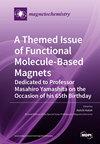SrLnCuSe3 (Ln = Dy, Ho, Er, Tm)化合物的磁性、光学和热学性质
IF 2.5
4区 化学
Q2 CHEMISTRY, INORGANIC & NUCLEAR
引用次数: 0
摘要
SrLnCuSe3 (Ln = Dy, Ho, Er, Tm)化合物在Pnma和Cmcm正交空间群中结晶,分别属于Eu2CuS3和KCuZrS3结构类型。通过单晶XRD研究,SrTmCuSe3的晶胞参数为a = 4.0631 (4), b = 13.4544 (14), c = 10.4430 (10) Å, V = 570.88 (10) Å3。在所研究的SrLnCuSe3样品在1.77 ~ 300 K温度范围内均表现出顺磁性行为,没有任何指向磁性有序的特征。测量的居里常数与Ln3+离子的居里常数吻合,准确度较高,证实了样品的化学计量成分和铜离子Cu1+ (S = 0)的非磁性态。光学吸收研究表明,多晶SrLnCuSe3 (Ln = Dy, Ho, Er, Tm)样品为半导体,直接带隙在2.14 ~ 2.31 eV之间。揭示了两个间接带隙,并通过在导带中存在到高色散子带的光学跃迁来解释。该化合物表现出两个可逆相变α - β, β - γ和在1606 K (Dy), 1584 K (Ho), 1634 K (Er)和1620 K (Tm)下的不一致熔化,与SrSe, Cu2-XSe和Ln2Se3二元化合物的固溶体形成有关。本文章由计算机程序翻译,如有差异,请以英文原文为准。
Magnetic, Optical, and Thermic Properties of SrLnCuSe3 (Ln = Dy, Ho, Er, Tm) Compounds
SrLnCuSe3 (Ln = Dy, Ho, Er, Tm) compounds crystallize in the Pnma and Cmcm orthorhombic space group and belong to the Eu2CuS3 and KCuZrS3 structural type, respectively. According to a single-crystal XRD study, the SrTmCuSe3 unit cell parameters are a = 4.0631 (4), b = 13.4544 (14), c = 10.4430 (10) Å, and V = 570.88 (10) Å3. All the studied SrLnCuSe3 samples in the temperature range of 1.77–300 K demonstrate paramagnetic behavior without any features pointing to magnetic ordering. The measured Curie constants coincide with the values expected for Ln3+ ions with good accuracy, which confirms the stoichiometric composition of the samples and the non-magnetic state of the copper ions, Cu1+ (S = 0). The conducted optical absorption study showed that the polycrystalline SrLnCuSe3 (Ln = Dy, Ho, Er, Tm) samples are semiconductors with a direct bandgap ranging from 2.14 eV to 2.31 eV. Two indirect bandgaps were revealed and explained by the presence of optical transitions to highly dispersive subbands in the conduction band. The compounds demonstrate two reversible phase transitions α⇆β, β⇆γ and an incongruent melting at 1606 K (Dy), 1584 K (Ho), 1634 K (Er), and 1620 K (Tm) associated with the formation of solid solutions of SrSe, Cu2-XSe, and Ln2Se3 binary compounds.
求助全文
通过发布文献求助,成功后即可免费获取论文全文。
去求助
来源期刊

Magnetochemistry
Chemistry-Chemistry (miscellaneous)
CiteScore
3.90
自引率
11.10%
发文量
145
审稿时长
11 weeks
期刊介绍:
Magnetochemistry (ISSN 2312-7481) is a unique international, scientific open access journal on molecular magnetism, the relationship between chemical structure and magnetism and magnetic materials. Magnetochemistry publishes research articles, short communications and reviews. Our aim is to encourage scientists to publish their experimental and theoretical results in as much detail as possible. Therefore, there is no restriction on the length of the papers. The full experimental details must be provided so that the results can be reproduced.
 求助内容:
求助内容: 应助结果提醒方式:
应助结果提醒方式:


